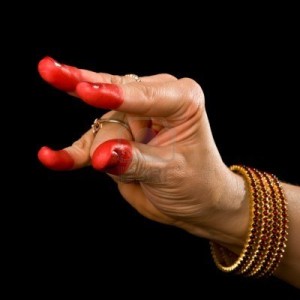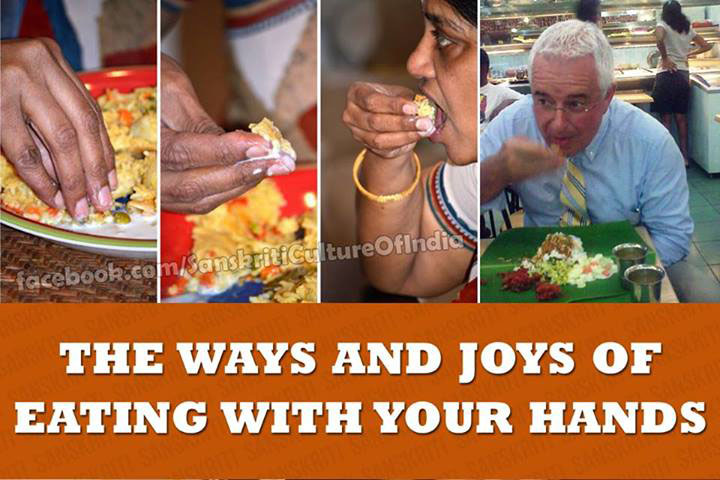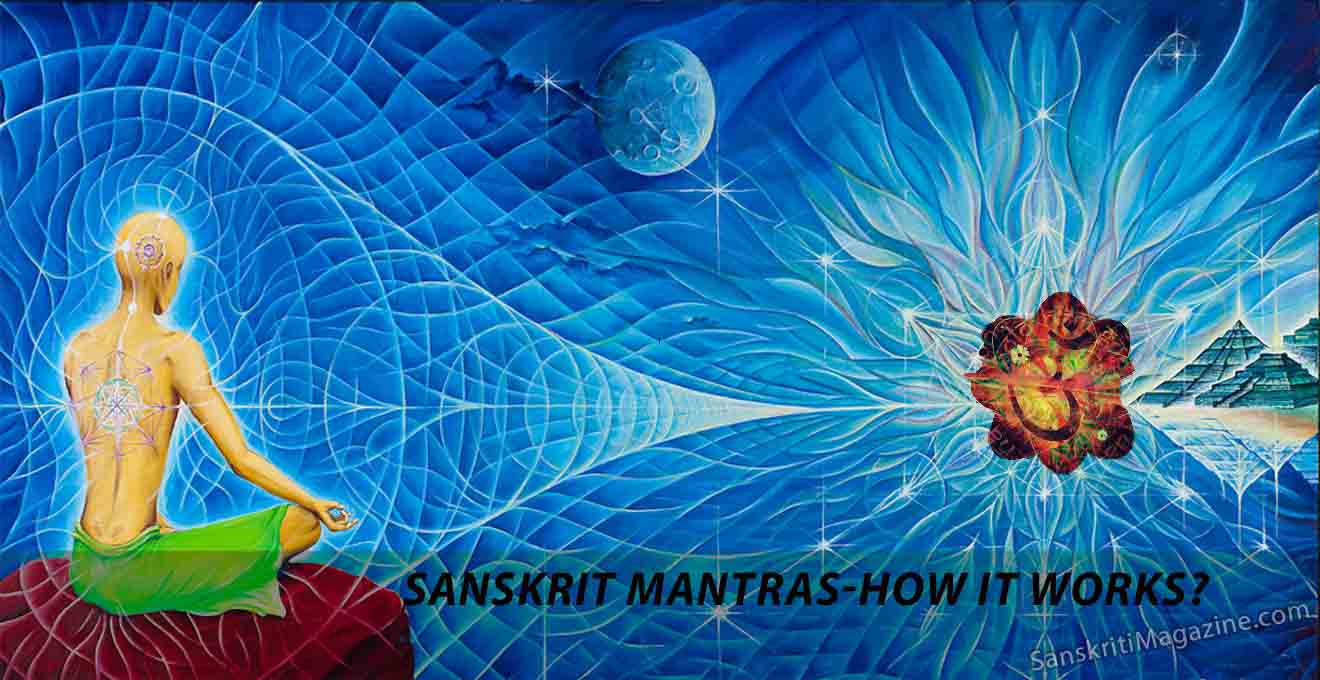Hands are considered our most precious organ of action. Our hands and feet are said to be the conduits of the five elements–space, air, fire, water and earth. One of the five elements courses through each finger. Through the thumb, angushtha, comes space; through the forefinger, tarjani, air; through the midfinger, madhyama, fire; through the ring finger, anamika, water and through the little finger, kanishtha, earth.
In Vedic tradition, we eat with our hands because the five elements within them begin to transform food and make it digestible even before it reaches the mouth. This transformation also heightens the senses so that we can smell, taste and feel the texture of the foods we are eating. We can also hear the sounds of eating. All of these sensations are a necessary prelude to beckoning agni, the fire of digestion, to ready itself for the meal to come.
On the greater dimension, the act of eating is spiritual feasting. We are activating the energies of the Deities aligned with the elements, stimulating a surge of heightened consciousness within. This is made possible through the powerful play of mudra. It brings the elements of nature through our hands and fingers into the food, and then joins it with agni. If we are aware of awakening the fire within ourselves, we digest not only the food but also our thoughts more smoothly. The fire of digestion and the fire of the mind, tejas, work hand-in-hand. As you see below, there are six specific mudras for eating.
 Ayurveda tells us that disease takes rise in the body because the digestive fire is awry and the mind is agitated. Most people today eat and run, juggling an overly full calendar. We often skip breakfast, eat a less-than-nutritious lunch, and that too in a hurry, and sit down to dinner late at night, after which we immediately fall into bed. How could proper digestion occur when we force the system to put up with such abuse year after year? In this frantic pace of living, how could we maintain composure in the mind and therefore remember the sacred purpose of these limbs? No wonder then that we have such a high incidence of cancer and heart disease, and ailments resulting from improper diet. We refuse to observe the integrity of our physiology by nourishing our bodies and souls with dignity and respect. Using the time-honored ways of sadhana can help us to restore health and harmony in our everyday lives.
Ayurveda tells us that disease takes rise in the body because the digestive fire is awry and the mind is agitated. Most people today eat and run, juggling an overly full calendar. We often skip breakfast, eat a less-than-nutritious lunch, and that too in a hurry, and sit down to dinner late at night, after which we immediately fall into bed. How could proper digestion occur when we force the system to put up with such abuse year after year? In this frantic pace of living, how could we maintain composure in the mind and therefore remember the sacred purpose of these limbs? No wonder then that we have such a high incidence of cancer and heart disease, and ailments resulting from improper diet. We refuse to observe the integrity of our physiology by nourishing our bodies and souls with dignity and respect. Using the time-honored ways of sadhana can help us to restore health and harmony in our everyday lives.
Eating food with your hands feeds body, mind and spirit. According to the Taittiriya Upanishad, food represents the coarsest and last of the five vestures in which the soul is clothed and passes from body to body in the long process of metempsychosis. In other words, food is not limited to what we eat, but expresses the universe’s entire body and all that is manifested within her. Likewise, we eat food not only to sustain the body, but to assimilate the universe’s elements and energies within our physical and emotional body and to nourish the greater, spiritual Self. The Taittiriya Upanishad tells us: “The essence of all things here is the Earth. The essence of Earth is water. The essence of water is the plant. The essence of the plant is a person.”
Let’s take this text a step further and ask ourselves: what is the essence of a person? I believe it is the fundamental nature that is uniquely ours and connects us to the universe. As humans, we are linked to the vast energy of the infinite, dimensionless universe by way of our limbs. The Purusha Suktam, a sixteen-mantra poem composed by the sage Narayana is regarded as the oldest work on cosmic anatomy and ecology. It reveals that the universe is an infinite continuum of energy. Yet it describes this energy as a living force, with eyes, ears, arms, legs, hands and feet and heads watching over all of existence. Just as the universe guards the many limbs and energies of its infinite structure, so each of us is meant to become aware of the greater life force and its many aspects. The sage explained that the individual who strives to live a spiritual life must first be aware of the life force and its many manifestations, limbs and faces before he can accomplish and serve it.
When we use our limbs in accord with the sacred laws of nature, every action worships and praises the omniscient Divinity in all things. When we eat with our hands, or feed the young and infirm with them, use them to dig into the rich soil and plant a good seed, embrace someone, or give them a gift, clasp the hands in prayer, we are using our hands to share in the maternal healing energies of the universe. Being conscious of how we use our hands is a wonderful act of sadhana.
To remind yourself each day of the sanctity of your limbs, recite the Vedic prayer, “Karagre vasate Laksmih karamule Sarasvati Karamadhye tu Govindah prabhate karadarsanam,” which means, “On the tips of my fingers is Goddess Laksmi, on the base of my fingers is Goddess Sarasvati, in the middle of my fingers is Lord Govinda. In this manner, I look at my hands.”
To start your mudra practice, engage anjali mudra. Each morning you engage this practice will help you remember the sanctity of your hands and your connection to the creative energies of our universe. In anjali mudra, bring the palms of your hands together in front of the heart, with fingers pointing upward. When we clasp the hands in this manner, we stimulate the prana, or energy, that circulates through the heart, which increases its vitality and brings us a sense of ease and resolve. To evoke the Deities, raise the clasped hands to the center of the forehead. This mudra is itself an act of prayer and helps to heal the heart, not only of the trespasses of the present life, but also of the wounds incurred through timeless rebirths. When you bring your hands together, you are transforming all five elements back into their source of tejas, the energy of the subtle fire of creation that is responsible for cellular and nuclear metabolism within and without. You will immediately feel oneness with the Divine.
We are all embarked on a lifelong quest for consciousness, which emerges from the cultivation of awareness, the inner knowing that depends entirely on the harmonious relationship we develop with nature. The aim of the food sadhana practices I advocate is to help us reconnect to the greater energy of the universe so that we may restore our cognitive memory that goes far back to the origin of the universe. Using mudras for eating and communing with the food we eat is a paramount step to connecting with cosmic energies and a vital means of receiving nourishment by touching upon the Earth’s bounty. The practice of these specific mudras is likely to open your heart to the Mother’s wisdom. Feast with your hands at Her table and you will never go hungry or angry. Food is memory. Eating with your hands is remembering your sacred nature.
While in the West eating with the hands usually conjures up pictures of a young child smeared from head to foot with food, in the East, using the hands as utensils is a highly refined art. Here are the six major ways in which the hands are used. (see newstand copy for illustrations):
In ghronikah mudra the five fingertips form a petal around a lump of food about the size of a plum. This is one of the two main mudras used for eating solid food like grains and vegetables, or for scooping dhals with chapati or bread.
In annabhakshana mudra, use the fingertips to pick up a small amount of food, sufficient to fit on the base of the four fingers. Use the thumb to advance the food forward and into the mouth. This is the second of the two main mudras for eating any solid food. Only the right hand is used for eating. Annabhakshana mudra practice cultivates our discrimination in eating good quality food in the appropriate quantity and in a tranquil environment.
 Kangulah mudra is taking food with the thumb, forefinger and mid-finger. Engage this mudra when eating long, slender pieces of food, like asparagus, carrots, celery, sugar cane and “drumsticks” or murungai. As we bring food to our mouth in kangulah mudra, the palm of the hand faces upward, evoking the spirit of consciousness as we touch upon Nature. This mudra cultivates a gentle reverence for Nature’s precious gifts. The first mudra, Ghronikah, activates and balances the element of earth within the body. The earth element controls our sense of smell and gives us added vision to “smell our way,” that is, to be keenly aware of our connection to Mother Nature.
Kangulah mudra is taking food with the thumb, forefinger and mid-finger. Engage this mudra when eating long, slender pieces of food, like asparagus, carrots, celery, sugar cane and “drumsticks” or murungai. As we bring food to our mouth in kangulah mudra, the palm of the hand faces upward, evoking the spirit of consciousness as we touch upon Nature. This mudra cultivates a gentle reverence for Nature’s precious gifts. The first mudra, Ghronikah, activates and balances the element of earth within the body. The earth element controls our sense of smell and gives us added vision to “smell our way,” that is, to be keenly aware of our connection to Mother Nature.
Kadambah mudra crouches the five fingers around firm, solid food. This mudra is reserved for eating round-shaped fresh fruits that fit neatly in the palm of the hand, such as apple, pear, mango or peach. You may also use it to eat sweets like ladhu. The mudra is named after the famed kadamba tree, which is said to put forth buds at the roaring of thunder-clouds, and which produces hard, inedible fruits. When Mother Nature is mistreated and taken for granted, she roars her thunder and makes rare her fruits. Practicing this mudra helps us to remember to be grateful for every speck of Nature’s food.
Mukulah mudra is eating with all five fingers tightly knitted together. In this mudra a minimal quantity of food is taken at a time, for example, ten grains of cooked rice. The mudra is used in annaprashanam, or the ceremony of first feeding, one of the 16 samskaras, usually performed in the fifth or sixth month of a child’s life. Mukulah mudra is a reminder that we are forever in the bud of life, continually regenerating the on-rushing flow of awareness. Every bite of food must serve to awaken cosmic memory of the first food we, as conscious human beings, imbibe from the Mother’s nectary.
Khatakamukhah mudra is tasting or sampling food with forefinger, mid-finger and thumb tightly pinched. This mudra measures the equivalent of a half-teaspoon. It is used to mete out spices and condiments in cooking. We may also use it as a pinch-measure for medicines. Food is the most potent form of medicine. We need to exercise caution. Keeping our hearts open but our hands half-closed when receiving food is a good policy to maintain. Khatakamukhah mudra helps us to exercise firm discretion around food.
~Bri. Maya Tiwari











